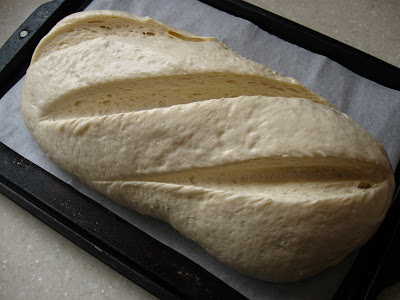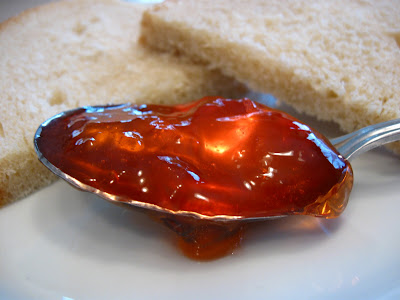But I have made time to play in the kitchen. Unfortunately, most of what I've been working on takes a few tries before I feel confident enough in the recipe to share it with you. Take this bread, for instance. Today was probably the fifth or sixth time I've made it in the last month and a half and I only now feel good enough about the recipe to post it. Now that the trial and error is over, it's time to enjoy! This bread is simple; there are only four ingredients. The crust is crispy, the crumb is moderately soft, and the flavor is perfect. It requires overnight fermenting, but it's very worth it.
The first step is to prepare the pre-ferment. Do this in the evening the day before you want to make bread. Alternately, if you want to have this bread fresh from the oven for dinner, you might be able to start the pre-ferement early in the morning and have enough flavor development. In this case, the fermenting step is almost entirely about flavor development; if you have to proceed before 10-14 hours have passed, so be it. This is what it will look like after you mix the first batch of ingredients. It is fairly easy to mix. It takes me four minutes to put together before I go to bed. Be sure to cover it and leave it out on the counter to work its magic overnight.
The next morning, it will be much bigger and full of bubbles. It will also have a distinctly ferment-y smell with a definite alcohol aroma. If you can't make the bread before lunch, then place the pre-ferment in the refrigerator until you are ready later in the day.
To finish the dough, add the remaining ingredients (except the salt) and mix with a paddle until it comes together, then switch to the dough hook. Knead on speed 2 (KitchenAid) for five minutes. Turn off the mixer and cover the bowl with plastic wrap or a towel and let it sit for 15-20 minutes. After this rest period, start the mixer back up and slowly add the salt so that it mixes in well. Continue kneading until the dough passes the windowpane test. This can take a while... much longer than you might think, in fact. If you or your machine needs to rest during the kneading period, no problem, cover and let it sit. Fortunately, this rest period helps to develop the dough as well. To get a good windowpane could take anywhere from 10 to 25 minutes after you add the salt. I know, I know. That's a lot of kneading! But it is very worth it. After the dough is ready, place it in an oiled bowl, cover, and let rise at room temperature until doubled, about an hour.
After the dough has risen, dump it on the counter and press it flat to get most of the air bubbles out. This can be a very gassy dough, so be prepared. If you handle it too much, the gluten can get a bit grumpy; if this happens, simply let the bread sit ten minutes before you try and shape it. Once you get this initial shape, roll it up and pinch the seams together to form a fat log (batard) shape.
Place the batard on a sheet pan lined with parchment. Cover loosely with plastic wrap and let rise again. This time, let it get really puffy... almost tripled in volume. It took mine only a little over an hour this morning. I tell you, my dough was hopping!
When the dough is almost tripled, begin preheating the oven to 450 F with a terra cotta saucer on the bottom rack. This saucer is our steaming mechanism. When the oven is ready, heat 1/3 cup of water to a boil and then slice the top of the loaf. In my post on baguettes, I talked about slicing loaves using a razor. I have since found the light. Why didn't anyone tell me the true trick is to use a serrated knife? What a difference! You still want to make sure your knife is wet so that it doesn't drag through the dough too badly, but it makes gorgeous slices this way. Cut three deep parallel slices into the loaf. Cut at a slight angle from the long axis. Spray the sliced loaf with cold water and place in the oven. Immediately add the 1/3 cup of hot water to the terra cotta saucer. The water will finish evaporating about the time you no longer want steam in the oven, so it's very convenient.
Bake at 450 F for 25-30 minutes, or until the inside of the loaf reaches between 200 and 205 degrees F. I use a thermometer to be sure. Remove from the oven and let cool before slicing. Look at how much additional oven spring this loaf had!
As for storage, if the loaf will not be finished the first day, wrap it in a flour sack towel to keep it fresh overnight. This keeps the bread from drying out too much without redistributing the moisture from the crumb to the crust. Wrapped in a towel, you will still have a decent crust on your loaf the following day. If it will take you longer than that to eat it, you'll want to store it in an airtight bag or container.
Peasant Loaf
Yield: one large (1 1/2 to 2 lb) loaf
For the pre-ferment:
2 cups bread flour
1/2 tsp instant yeast
1 cup warm water
Mix these three ingredients together in a bowl. Cover the bowl with plastic wrap and let sit on the counter overnight (or at least 10 hours).
For the dough:
all of the pre-ferment
1 1/2 cup bread flour
1 1/2 tsp instant yeast
1/2 cup warm water
1 tsp salt
Mix all ingredients except for the salt together in the bowl of a stand mixer. Mix with a paddle attachment until the dough comes together and then switch to a dough hook. Knead on low speed (KitchenAid speed 2) for five minutes. Turn off the mixer, cover the bowl with plastic wrap or a towel, and let sit for fifteen to twenty minutes.
Uncover the bowl and begin kneading again. Slowly add the salt so that it incorporates evenly. Continue kneading until the dough passes the windowpane test. This can take quite a while, anywhere from 10 to 25 minutes. If you or the mixer needs a break, simply cover the dough and let it sit 5-10 minutes before proceeding.
When the dough is ready, place it in an oiled bowl, cover, and let rise at room temperature until doubled (about an hour). Dump the dough out onto the counter and press it flat into a rectangle. Knock out the gas and then roll up into a batard shape. Pinch the seams together. Place seam side down on a parchment lined sheet pan. Cover loosely with plastic wrap and let rise until nearly tripled (about another hour or so).
When the dough is almost ready, preheat the oven to 450 F with a terra cotta saucer on the bottom rack and heat up 1/3 cup of water. When the oven is preheated, make three parallel slices deep (3/4" to 1" deep) into the bread with a wetted serrated knife. Spray the loaf with cold water. Place the bread in the oven and pour the heated water into the saucer. Close the oven door and let bake undisturbed fr 25-30 minutes, or until the internal temperature reaches 200-205 F. A thermometer is the most accurate way to check. Remove from the oven and let cool completely,
NOTE: If you just can't handle kneading the dough as long as it might take to pass the windowpane test, it's not the end of the world. The texture of the finished loaf will not quite be the same and the loaf may not get as large, but it will still be very tasty!

















